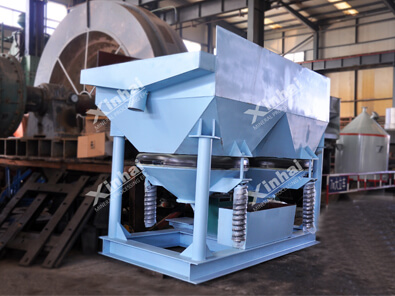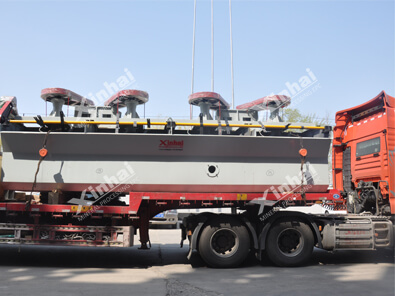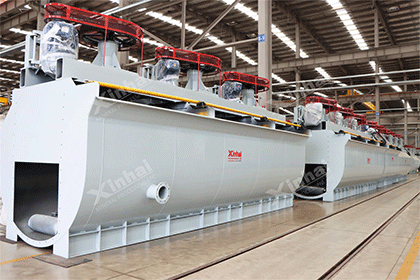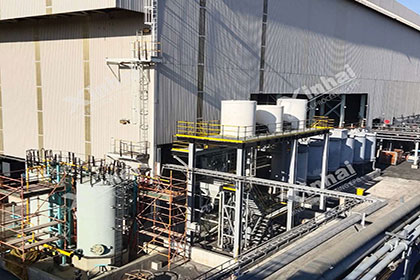What is Iron Ore Treatment? | Iron Ore Beneficiation
 Laura
Laura
 Oct 25, 2022
Oct 25, 2022
 1238
1238
If you want to know more details about equipment, solutions, etc, please click the button below for free consultation, or leave your requirements!

( Mongolia 3500tpd iron ore mining tailing project design )
Iron ore is mainly used in the production of iron and steel. Natural iron ore needs to be processed through a series of processes such as crushing, grinding, magnetic separation and flotation to gradually select iron. So what is iron ore treatment? In this article, we will focus on iron ore processing by introducing the iron ore types, iron ore chemical composition and the two main iron ore beneficiation processes. Let's start it!
01Iron Ore Types
BackIron ore types can be divided into two categories: natural and industrial. The natural type is a combination of ore minerals according to the material components, structure and structure of the ore; the industrial type is an ore type divided according to the different methods and processes of ore dressing and smelting in the industry.
1 Natural type Iron Ore
(1) According to the type of iron minerals are divided into magnetite, hematite. Pseudomorphic (semi-pseudomorphic) hematite, vanadium-titanium magnetite, limonite, rhodochrosite and two or more iron-bearing minerals composed of mixed ores.
(2) According to the harmful impurities (S, P. Cu, Pb, Zn, As, Sn, F) into high sulfur iron ore, high phosphorus iron ore, etc..
(3) According to the structure of the ore can be divided into dip ore, network vein dip ore, strip ore, dense block ore, breccia ore, as well as Maeny. bean-like, kidney-like, honeycomb-like, powder-like and earth-like ores, etc.
(4) According to the vein minerals can be divided into quartz, amphibole, pyroxene, plagioclase, serpentine chlorite, silica, actinolite, serpentine. Iron dolomite type and jasper type iron ore.
2 Industrial type Iron Ore
According to the different ore selection and metallurgy methods and processes in the industry, the type of ore is divided.
In the enterprise economy, depending on the balance between input and output: the ore that can be used in industry is called basic reserve ore, including iron ore for steel making, iron ore for iron making and ore to be selected.
Iron ore industrial type generally to iron ore iron content of more than 85% of the total iron in a certain iron-containing minerals to name.
For magnetite and hematite, the magnetic iron (MFe) to total iron (TFe) occupancy is used to divide: MFe/TFe≥85% magnetite, MFe/TFe≤85% ~15% magnetite-hematite (rhodochrosite) mixed ore, MFe/TFe<15% hematite.
According to the production experience of Chinese mines, single weak magnetic separation of iron ore MFe/TFe >65% , other process separation of iron ore MFe/TFe<65%. According to the selection and metallurgy requirements, iron ore is divided into the following types:
(1) According to the composition and nature of iron ore is divided into magnetite, hematite, rhodochrosite, limonite and mixed ore.
(2) According to the iron ore iron and impurity content is divided into steel rich ore, iron rich ore, general rich ore and poor ore, etc.
(3) According to the degree of iron ore oxidation is divided into primary ore, oxidized ore and mixed ore, TFe/Fe0
(4) According to the content of iron ore slagging components are classified as acidic ore, self-fusing ore, semi-fusing ore and alkaline ore.
Self-fusing ore ( CaO +MgO)/( SiO,+ Al,0,) =0.8~1.2
Semi-fusible ore ( CaO + MgO)/ ( SiO,+ Al,0,) = 0.5 ~ 0.8
Acidic ore ( CaO + MgO)/( SiO,+ Al0)<o.5
Alkaline ore ( CaO + MgO)/(SiO,+ Al,03) >1.2
(5) Iron ores are classified according to the content of other components as
High sulfur ore (S>0.3%)
High phosphorus ore (P>0.2% ~0.8%)
Phosphorus-rich ore (P>0.8%)
High copper ore (Cu0.2% ~0.5%)
Copper-rich ore (Cu>0.5%)
High zinc ore (Zn>0.1%)
High arsenic ore (As>0.07%)
High chromium ore (Cr>2%)
High tin ore (Sn >0.08%)
High drill ore (Co>0.03%)
High lead ore (P>0.1%)
Iron vanadium ore ( V,0, >0.2%)
ilmenite (TiO, >5% ).
When the iron ore, in addition to magnetite, also contains divalent iron vein minerals or rhodochrosite, pyrite and other minerals, it will affect the ratio of TFe/Fe0, which can not truly reflect the magnetic properties of iron ore.
02Iron Ore Chemical Composition
BackThe chemical composition of iron ore can be divided into four parts: iron, harmful impurities, useful components and slag-making components.
1 Iron
Under the same conditions, the higher the iron grade in the ore, the better the blast furnace smelting index.
For metallurgical treatment of raw materials, the main requirement is the quality and stability, especially the iron grade, blast furnace smelting indicators and the iron grade in the ore and concentrate.
2 Harmful Impurities
S, P, As, Zn and Pb are harmful impurities.
Harmful impurities can affect the quality of pig iron, steel or production efficiency. For the rich ore directly into the furnace smelting, the content of harmful impurities need to be limited.
When the harmful impurities exceed the requirements, the ore needs to be beneficiated before use or for the material for ore blending.
3 Useful Components
Mn, Ni, Co, V, Cu, Cr and Ti are useful components of the ore.
Copper, chromium and titanium in addition to good properties also have adverse effects, so that the metallurgical process is complicated.
4 Slag-Making Components
Vein for slag-making components, generally divided into alkaline and acidic two.
Calcium oxide and magnesium oxide belong to the alkaline, silica and aluminum oxide belong to the acidic.
The higher the ratio of total alkaline components to total acidic components in the ore, the more can reduce the consumption of the main solvent.
Belonging to the slag-making components are: K,0, Na,0, TiO. and BaO, etc. For ores offered for direct use in the furnace, the content of the slagging components needs to be identified.
When MgO, Al,0, are very low in the ore, CaO/SiO can be used directly to determine the acidity and alkalinity.
03Magnetite Beneficiation Process
Back1 Single Magnetite Ore Beneficiation Process
Single magnetite ore is often selected by weak magnetic separation method.
For large and medium-sized magnetic separation plant, when the grinding size is greater than 0.2 mm, a section of the mill magnetic separation is often used; less than 0.2 mm, two sections of the mill magnetic separation.
If in the coarse grinding can be divided into qualified tailings, the stage grinding magnetic separation is used.
2 Polymetallic Magnetite Ore Beneficiation Process
Containing polymetallic magnetite generally use weak magnetic separation and flotation combined process to select, that is, with weak magnetic separation to recover iron, flotation to recover sulfide or apatite, etc..
The principle process is divided into two types of weak magnetic separation - flotation and flotation - weak magnetic separation.
These two processes of magnetite and sulfide congeners go to different directions. In the former process, the congeners mainly go into the iron concentrate; in the latter process, they mainly go into the sulfide concentrate.
Therefore, with the same grinding size, the first float and then magnetic process can obtain iron concentrate with lower sulfide and sulfide concentrate with higher recovery.
04Magnetite-hematite / magnetite-rhodochrosite Beneficiation Process
Back1 Single magnetite - hematite Beneficiation Process
(magnetite - rhodochrosite Beneficiation Process)
The iron minerals in the single magnetite-hematite/magnetite-rhodochrosite are magnetite and hematite or rhodochrosite, mostly fine-grained embedded; the veinstones are mainly quartz, some of which contain more iron silicate.
The proportion of magnetite in the ore is variable, gradually increasing from the surface to the depth of the deposit.
Two methods are commonly used for the beneficiation of single magnetite-hematite/magnetite-rhodochrosite.
a Weak magnetic separation combined with re-election, flotation and strong magnetic separation.
b magnetization roasting magnetic separation method or parallel process with other methods.
2 Containing polymetallic magnetite - hematite Beneficiation Process
(magnetite - rhodochrosite Beneficiation Process)
The iron minerals in magnetite-hematite/magnetite-rhodochrosite are mainly magnetite and hematite or rhodochrosite, medium to fine grained embedded; the vein minerals are silicate and carbonate minerals or lapis lazuli, etc.; the associated components are apatite, pyrite, chalcopyrite and rare earth minerals, etc.
The beneficiation method of magnetite - hematite / magnetite - rhodochrosite is the most complex in iron ore, generally using a combined process of weak magnetic and other methods, i.e. recovery of magnetite by weak magnetic separation; recovery of weak magnetic iron minerals by re-election, flotation or strong magnetic separation and recovery of associated components by flotation.
05Summary
BackThe above has described the types of iron ores, their chemical composition and the beneficiation processes for the two main types of magnetite and magnetite-hematite and magnetite-rhodochrosite. In the actual iron ore beneficiation, specific problems need to be treated, and the specific beneficiation process should be judged according to the nature of the ore and other relevant information. Welcome to click chat button to learn more about iron ore beneficiation.
 +86 13810565920
+86 13810565920 xlyin@xinhaimining.net
xlyin@xinhaimining.net




 Message
Message Chat Now
Chat Now




















